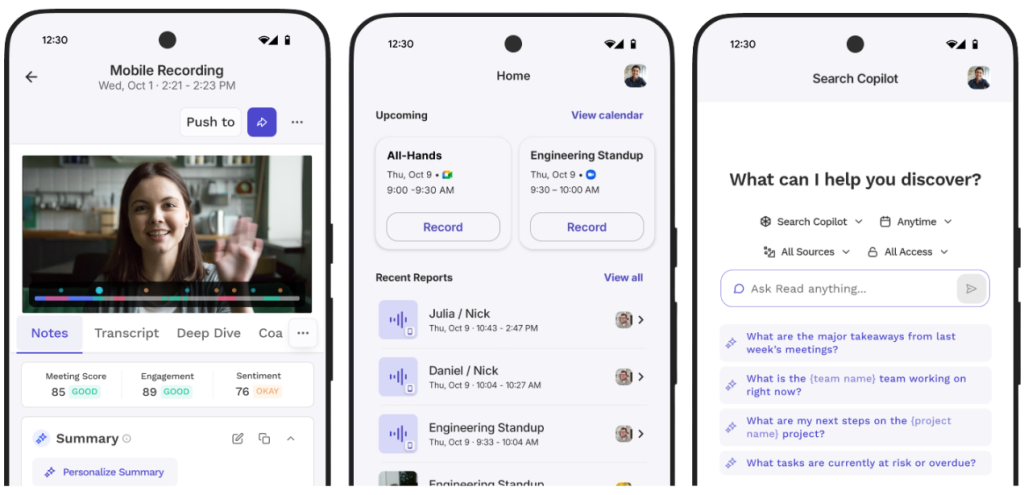Read AI Expands from Virtual to Physical World with New Operator System
In an era where the boundaries between digital and physical workspaces continue to blur, Seattle-based startup Read AI is making a significant pivot beyond its roots in virtual meeting analysis. On Wednesday, the company unveiled “Operator,” a comprehensive system designed to capture, transcribe, and analyze workplace interactions across all environments – whether they occur in scheduled video calls, impromptu hallway conversations, or formal in-person meetings. This expansion represents a strategic response to the evolving nature of workplace communication, where increasing numbers of professionals are returning to office settings while maintaining hybrid work arrangements.
The timing of Read AI’s new offering aligns with a notable shift in workplace dynamics. According to the company’s recent research, in-person and unscheduled meetings now account for 53% of all professional interactions, marking a 6% increase since 2023. This trend underscores the growing importance of capturing valuable information exchanged during spontaneous conversations that might otherwise be lost. Recognizing this evolution, Read AI has expanded its platform across multiple access points, launching new desktop applications for Windows and macOS, adding Android compatibility to complement its existing iOS app, and maintaining its browser-based functionality. This multi-platform approach ensures that professionals can seamlessly integrate the technology into their preferred devices and workflows without disruption.
Unlike competitors in the AI meeting assistance space such as Limitless and Plaud, which have embraced dedicated wearable recording devices, Read AI has deliberately chosen a hardware-agnostic approach. CEO David Shim explained the company’s philosophy in a recent GeekWire Podcast interview: “I don’t think we’d ever build a device, because I think the phones themselves are good enough.” This perspective challenges the notion that specialized hardware provides superior functionality, instead betting that most professionals would prefer using the sophisticated recording capabilities of devices they already own rather than purchasing, charging, and wearing additional gadgets. This strategy potentially removes a significant adoption barrier while leveraging the ubiquity and continual improvement of smartphone technology.
The introduction of real-world recording capabilities inevitably raises questions about privacy and consent. Read AI has addressed these concerns by implementing a user-driven notification system rather than automated announcements. When a recording begins, the application prompts users to inform participants either verbally or through text that the conversation is being captured. On mobile devices, the system maintains a persistent visual indicator throughout the recording session to ensure transparency. While this approach places significant responsibility on users to obtain proper consent, it reflects the complex balance between seamless technology integration and ethical considerations in workplace monitoring. The effectiveness of this approach will likely depend on organizational cultures and individual compliance with privacy best practices.
Founded in 2021 by the team of David Shim, Robert Williams, and Elliott Waldron, Read AI has established itself as a significant player in the workplace productivity space, securing more than $80 million in funding and building an impressive user base of 5 million monthly active professionals. The company reports 24 million connected calendars to date, demonstrating substantial penetration in enterprise environments. What distinguishes the Operator rollout from typical product expansions is the company’s decision to include this new functionality within existing subscription plans at no additional cost. This approach suggests confidence that enhanced capabilities will drive user engagement and retention, potentially leading to expanded enterprise adoption rather than immediate revenue increases from existing customers.
As workplaces continue evolving toward hybrid models that blend remote and in-office work, tools like Read AI’s Operator represent the next frontier in professional communication technology. By capturing, analyzing, and providing insights from the full spectrum of workplace interactions, such systems promise to reduce information silos and create more comprehensive knowledge repositories. However, their success will ultimately depend on striking the right balance between technological capability and human-centered design – ensuring that AI augments rather than disrupts natural workplace dynamics. Read AI’s phone-first approach to spontaneous conversation capture represents a fascinating test case for how extensively professionals are willing to integrate AI into their daily work routines, and whether the benefits of comprehensive conversation analysis outweigh potential concerns about continuous workplace monitoring.


